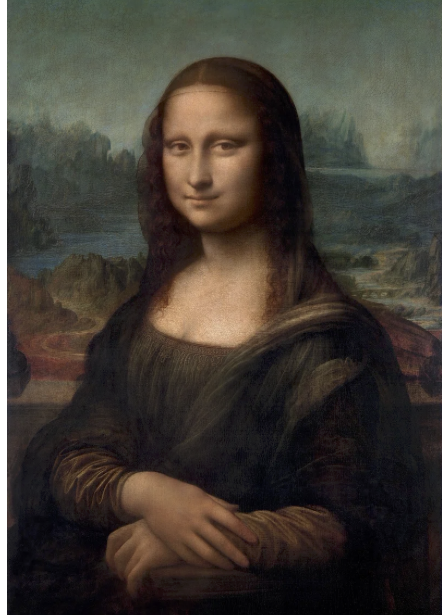Imagine you’re at an art museum. Grand halls lined with famous paintings and people quietly admiring them in crowds, guides offering offhand information to eachother about the apparently fantastic pieces in front of them – but, picture this (pun intended)… you have absolutely no idea what they’re talking about! It’s all boring gibberish steeped in convoluted history, and would make any new museum-go-er want to museum-go-out, whether they’re in the National Gallery or the Louvre.
Now, for those of you that didn’t need much imagination to conjure up that last image, what if I told you that art history can be fun and easy to understand? In this article, you’ll be taken on a whirlwind tour through almost 500 years of Western art history encompassing most of what you’re likely to see in museums, and we’ll use one famous painting from every significant art period to explain what each art movement wanted to achieve. Tickets please! And bon(ne) voyage!
THE RENAISSANCE – 1300-1600 (approx)
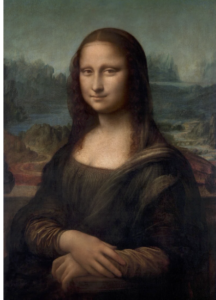
We begin at the “Mona Lisa”, arguably the world’s most famous painting! (Cliche, I know.) However, it is no less important in Art History just because of it’s popularity. The “Mona Lisa” was painted by Leonardo Da Vinci between 1503-1519 and represents well the height of the Renaissance movement. Meaning “re-birth” in French, this period of time and it’s accompanying art movement was characterised by an intense interest in developing what people knew about the world, and saw leaps in development within art, music, literature and the sciences, all of which often overlapped as professions in this period. In art specifically, there was a large interest in realism. This meant painters strived to paint people as accurately as possible, and it’s seen in Mona Lisa’s infamous half-smile that still intrigues viewers today. Some interesting art techniques used on this particular painting are “sfumato”, an Italian term meaning is blending shades of colour together without drawing borders between objects to create a more realistic image.
THE BAROQUE – 1600-1730
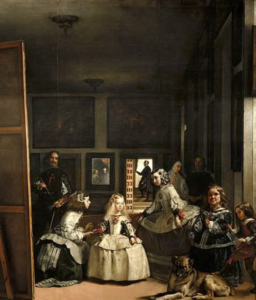
As the Renaissance began to end, the leading minds of society turned away from the precision and scientific and artistic innovations of the Renaissance and towards a new, Baroque style that appealed more to human emotion and beauty. Basically, people began liking their paintings far more dramatic! Painters began using dramatic transitions between light and dark areas to draw focus to areas and create more dramatic compositions, and this is called “chiaroscuro” (literally meaning light-dark in Italian) .Paintings also began capturing more slice-of-life images. Both of these changes can be seen in this painting,“Las Meninas” by Paul Velasquez, (who, in probably the world’s first photobomb you can actually see painting in the far left). It shows the daughter of Spain’s King Phillip VI and her entourage, and was painted in 1656.
NEOCLASSICISM – 1750-1830

As you are probably beginning to see, most of the changes between art movements were caused by society starting to disagree with the ideas behind the old ones – granted, that is a giant oversimplification, but we’d be here all day if we went into tiny details. The rise of Neoclassicism was no different, and was actually about getting rid of those ‘tiny details’ and the vanity everyone started to see born from the Baroque’s vain excesses. Neo-classicism (meaning literally new classicism) was a revival of principles of arts that people held in the Ancient Greek and Roman civilisations. Neoclassicists believed that art again should represent the ideals virtues in life, and that looking at a painting should teach it’s viewer a moral or message. A famous painting from this period is the “Oath of the Horatii” by Jacques-Louis David in 1784-5 , and the Roman influence is clear from the Ancient Roman setting of the painting. Art in this period used clear horizontal and vertical lines in their compositions, inspired by Greek and Roman architecture. Straightforward, no-nonsense – right?
ROMANTICISM 1770-1880
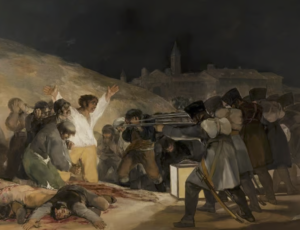
…Well, not really. The world wasn’t as logical as the Neo-classical ideals made it out to be, and Romanticism moved back to emotion. This time around, art focused on the individual and a right to freedom and individual opinion. This was also influenced by the French Revolution happening simultaneously . “Third of May 1808” by Francisco Goya, painted 1814, shows exactly those ideas about freedom and individuality.This painting was significant due to it’s flat perspective and ungraceful portrayal of the people present, portraying the raw fear of the Spanish peasant facing execution by Napoleon’s troops. Paintings also began to delve more in depth into psychology and the moods of their subjects within this era. A particular art technique to note here is the contrast between the peasant’s bright colours and lighting and the soldier’s exaggerated dark uniforms and perspective shortening (combining them into an opposing force rather than individuals).
IMPRESSIONISM 1860-1890
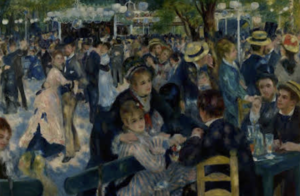
These previous art styles were all very well and good, but by the 19th century the world around artists had started to change drastically, and there rose a need to reflect this modern landscape. Impressionism strove to accomplish that, with a focus on the subtleties of light and colour and their transient (or ‘impression-like’) nature.
Pierre Auguste Renoir’s painting, “Bal du moulin de la Galette”, painted in 1876, is a famous example of this. The Impressionists were unique for their treatment of how light and colour worked together, and this is seen by the stippling of light on the subjects sitting under the greenery. This was achieved using short, thin and visible brushstrokes that often used far more paint than in previous art styles. This paint heavy brush style was called “impasto” painting.
With this fashionable Parisian scene, we arrive nearly to the 20th century, and so end our speedy tour of The Print’s history highlights museum. We hope this encourages our readers to begin their more detailed foray into the rich canvas of art history!

